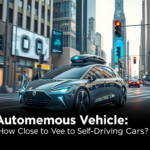Discover the current state of autonomous vehicles, the challenges they face, and how close we are to seeing fully self-driving cars on the roads. Learn about the technology, regulations, and future of autonomous driving.
Introduction
Self-driving cars have long been a symbol of futuristic technology, often depicted in sci-fi movies and novels. Today, autonomous vehicles (AVs) are no longer just a fantasy—they are a tangible reality being tested and deployed worldwide. But how close are we to fully autonomous cars dominating our roads? This article explores the current state of autonomous vehicle technology, the challenges it faces, and what the future holds for self-driving cars.
What Are Autonomous Vehicles?
Autonomous vehicles, or self-driving cars, are vehicles capable of navigating and operating without human intervention. They rely on a combination of advanced technologies, including artificial intelligence (AI), machine learning, sensors, cameras, radar, and LiDAR (Light Detection and Ranging). These systems work together to perceive the environment, make decisions, and control the vehicle.
The Society of Automotive Engineers (SAE) has defined six levels of driving automation, ranging from Level 0 (no automation) to Level 5 (full automation). Most vehicles on the road today are at Level 2 (partial automation), where the car can control steering and acceleration but requires human supervision.

The Current State of Autonomous Vehicles
Several companies and organizations are at the forefront of autonomous vehicle development. Here’s a look at the current landscape:
- Tesla: Tesla’s Autopilot and Full Self-Driving (FSD) features are among the most well-known semi-autonomous systems. While not fully autonomous, these systems offer advanced driver-assistance capabilities.
- Waymo: A subsidiary of Alphabet (Google’s parent company), Waymo has been testing fully autonomous vehicles in cities like Phoenix, Arizona. Their vehicles operate at Level 4 autonomy, meaning they can handle most driving tasks without human intervention in specific areas.
- Cruise: Backed by General Motors, Cruise is another major player in the AV space, focusing on ride-hailing services with self-driving cars.
- Traditional Automakers: Companies like Ford, BMW, and Toyota are also investing heavily in autonomous technology, often partnering with tech firms to accelerate development.
Despite these advancements, fully autonomous vehicles (Level 5) are not yet commercially available. Most systems today are limited to specific geographic areas, weather conditions, and driving scenarios.
Challenges Facing Autonomous Vehicles
While the technology is advancing rapidly, several challenges must be addressed before self-driving cars become mainstream:
- Technological Limitations:
- Sensor Reliability: Sensors like LiDAR and cameras can struggle in adverse weather conditions, such as heavy rain or snow.
- AI Decision-Making: Teaching AI to handle complex and unpredictable driving scenarios remains a significant hurdle.
- Cybersecurity: Autonomous vehicles are vulnerable to hacking, which could lead to dangerous situations.
- Regulatory and Legal Hurdles:
- Governments worldwide are still developing frameworks to regulate autonomous vehicles. Key issues include liability in accidents, safety standards, and data privacy.
- Inconsistent regulations across regions can slow down the deployment of AVs.
- Public Acceptance:
- Many people are skeptical about the safety and reliability of self-driving cars. High-profile accidents involving autonomous vehicles have further fueled these concerns.
- Building public trust will be crucial for widespread adoption.
- Infrastructure Requirements:
- Autonomous vehicles require smart infrastructure, such as connected traffic lights and road sensors, to operate efficiently. Upgrading existing infrastructure will be a massive undertaking.

The Future of Autonomous Vehicles
Despite the challenges, the future of autonomous vehicles looks promising. Here’s what we can expect in the coming years:
- Increased Adoption of Level 4 Autonomy:
By 2030, Level 4 autonomous vehicles (high automation) are expected to become more common, particularly in ride-hailing and delivery services. - Transformation of Urban Mobility:
Self-driving cars could revolutionize urban transportation, reducing traffic congestion, lowering emissions, and providing mobility solutions for underserved populations, such as the elderly and disabled. - Economic Impact:
The autonomous vehicle industry is projected to be worth hundreds of billions of dollars by 2030, creating new jobs and business opportunities. - Integration with Smart Cities:
Autonomous vehicles will play a key role in the development of smart cities, where connected infrastructure and IoT devices enable seamless transportation.
Conclusion
While fully autonomous vehicles are not yet a reality for everyday consumers, the technology is advancing at an unprecedented pace. Companies are making significant strides in overcoming technical and regulatory challenges, and public acceptance is gradually increasing. As we move closer to a future dominated by self-driving cars, the potential benefits—ranging from improved safety to enhanced mobility—are immense. The road to fully autonomous vehicles may still have a few bumps, but the destination is within sight.







